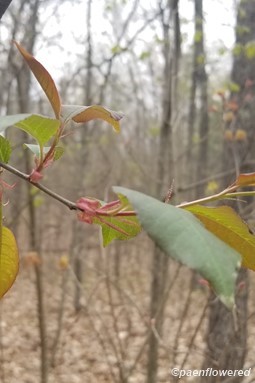Prunus serotina
Black cherry is known for its wood and beautiful small flowers in long, drooping racemes
Prunus serotina black cherry
A deciduous tree growing up to 30 m tall, the wood of this tree is considered valuable and used for furniture. The bark and leaves have a distinct aromatic smell. Leaves are glossy on the upper side, oblong with a pointed tip, and appear before the flowers. Black cherry is a timber species on the Allegheny plateau. Maybe confused with Prunus virginiana. Black cherry's leaves are not as broad and petioles not of red color. Sepals persist until the stalk withers away unlike those of chokecherry.
Habitat & Range
Grows in forests and fencerows, widely present throughout the Allegheny plateau.
Found throughout the state.
| EMP: | FACU |
|---|---|
| NCNE: | FACU |
Phenology
Flowers from May to June, after the leaves.
Red fruit changes color to black around August.
Characteristics
Leaves simple and alternate, elliptical to oblong with a sharply pointed tip, rounded at the base, on a stalk about 1 in long. The upper surface is dark green and glossy, lower is mostly smooth or maybe with sparse hairs near the base. Margins have fine blunt teeth with dark, gland-like tips.
Flowers numerous, in nodding, cylindrical racemes up to 4 in long, each raceme has 20 to 60 short-stalked flowers, stalks are smooth and slender. Flowers have five white, round petals, and a reddish-orange center.
Bark aromatic, grayish brown on young trees and becomes dark gray to black with coarse scaly plates on older trees.
Fruit round drupe, turning from green to reddish purple to almost black; single hard seed inside. Sepals persist until the stalk drops off.
Identification Tips
White flowers are held in long, drooping racemes
Similar Species
Prunus virginiana (chokecherry)
Chokecherry has sharp, thin teeth on leaf margins; has distinctive red petioles & broader leaves than black cherry.
Plant Codes
S-rank: No Rank
G-rank: G5 (Secure)









.jpg?v=638134808320000000)


Comments
Have you spotted this plant in your area? We'd love to hear about your experience! Share your comments or questions about the plant below. Comments are moderated before posting.